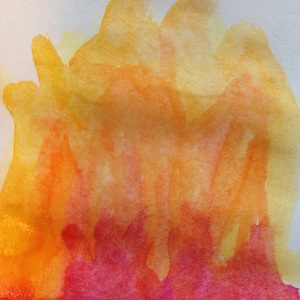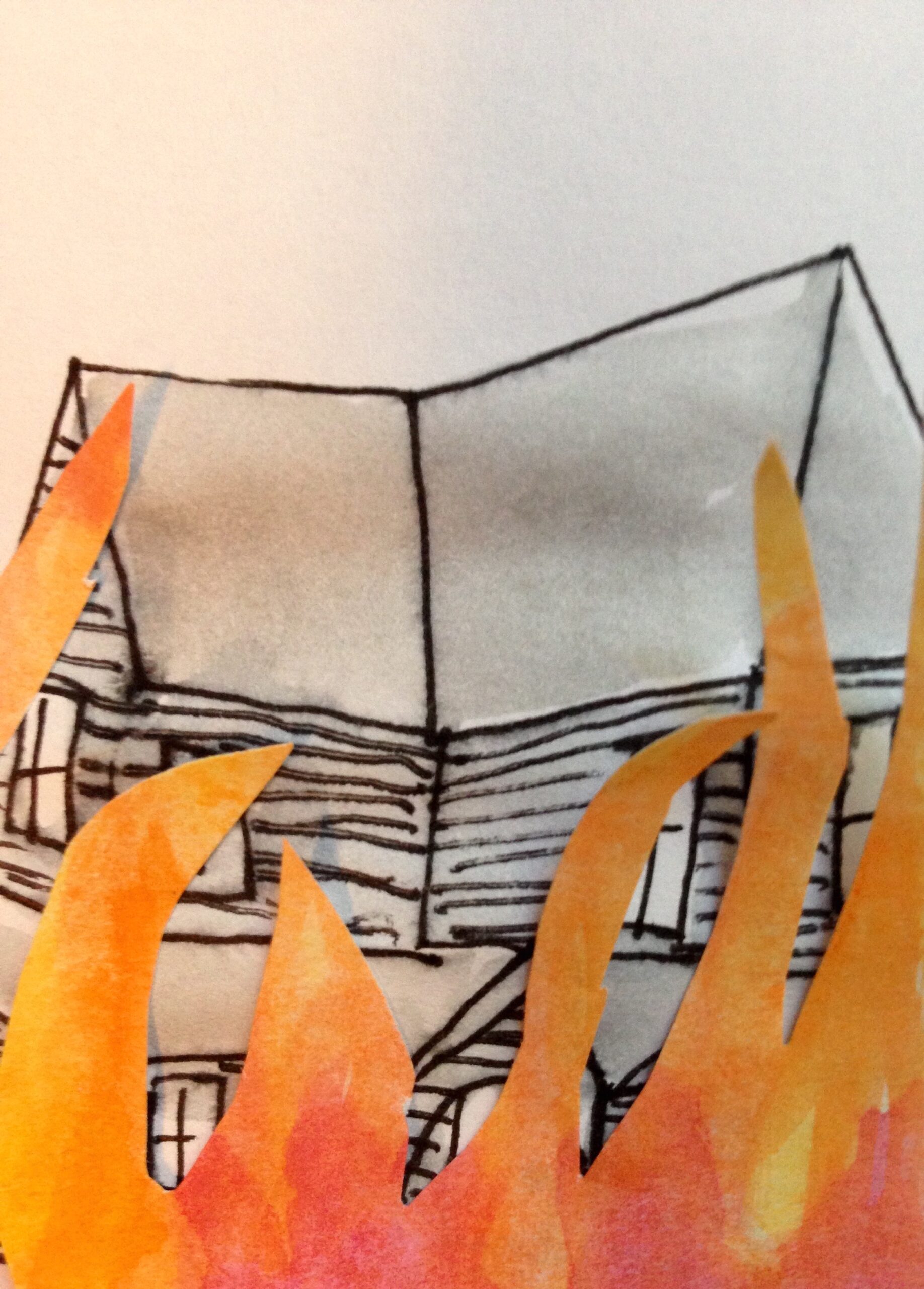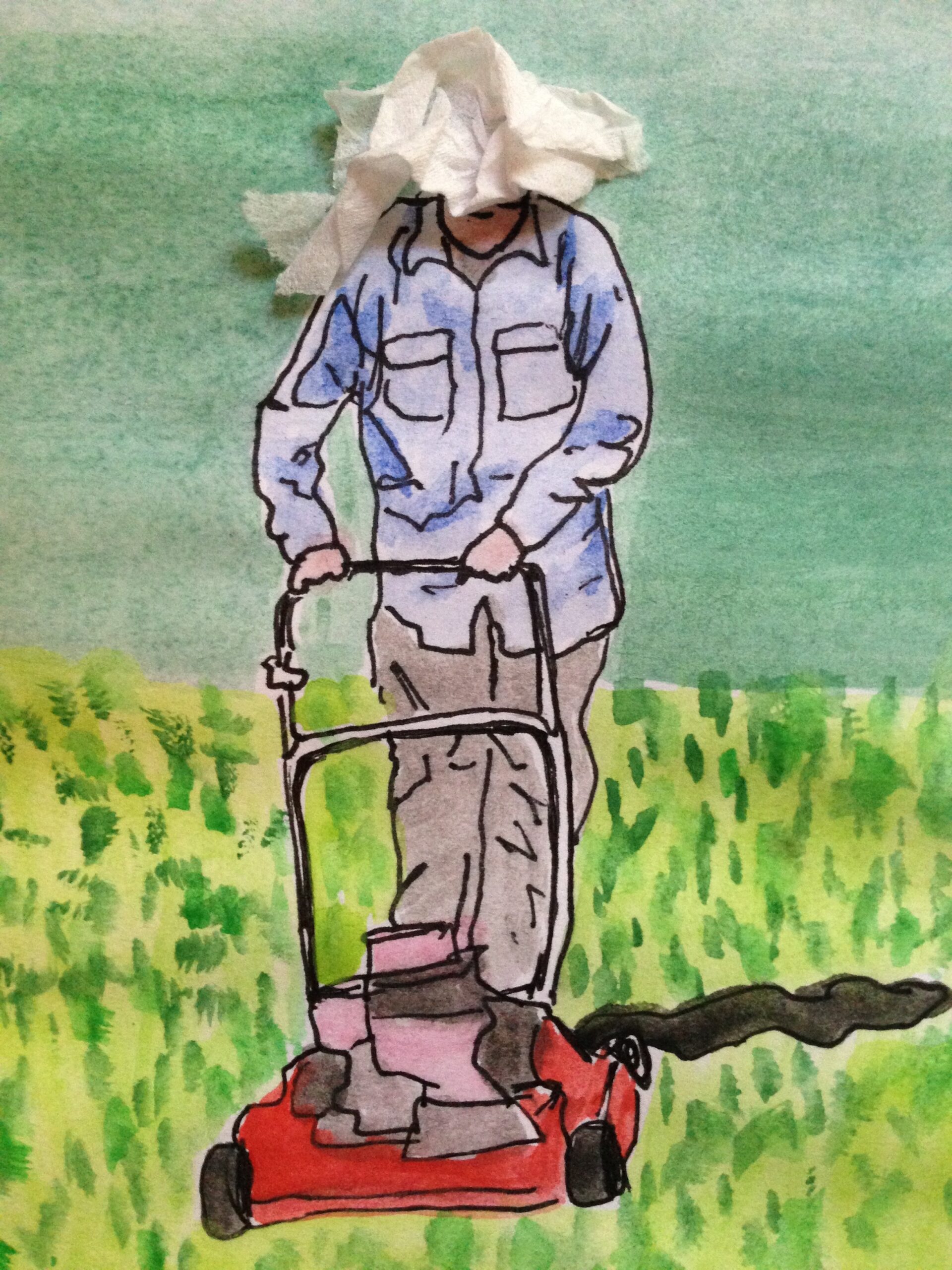
Shortly after noon on December 22, 2014, while I was walking my dogs to Sander Farms, a natural preserve of 34 acres of open space abutting the boundary of the subdivision where I live, I saw a great gathering of emergency vehicles parked around the last house on the street. All of the fire and police employees of my small town must have been summoned. The parameter of the property was roped off with ominous yellow emergency tape saying Police Don’t Cross over and over. It took me a few moments to grasp that the tape meant this house that I pass everyday on my walk to the fields was a crime scene. Death doesn’t send a calling card.
I’ve often encountered the man who lives in this house mowing the entrance to Sander Farms that lies at the lower corner of his yard. What a neighborly gesture, I’ve thought; he didn’t have to mow that stretch, as it wasn’t part of his property. The house is pale blue with a white balcony running the length of the back looking out to the fields. I often envied the view from that balcony, wondered what he saw from his spot when the fields were lit by moonlight. A camper with peace signs was usually parked in the driveway and a Pomeranian dog barked in the unfenced yard. I never spoke with his wife though I sometimes saw them in the yard together with their dog. At the end of last summer a rough homemade “For Sale” sign popped up in the yard, announcing the house was for sale, and then it disappeared.
Windows had been knocked out and propped up against the side of the house. From where I stood outside the property lines, I couldn’t see any other damage to the house because the damage was to the interior, what couldn’t be seen or smelled from the street. I didn’t stop to ask questions, to pry, although of course I wanted to, but it wasn’t my place to interrupt and I proceeded to the fields. An hour later when we departed, the vehicles were exactly as they had been, parked in a rush at odd angles. Some men were digging in the front yard and one man was suspended high above the house in the extended arm of the big fire engine. I didn’t know what either of them were doing.
Walking slowly on my way home, I was shaken, struck more deeply that something terrible had happened. Later that evening my husband told me someone had posted a link to a news story on our neighborhood web site—it seemed that a body had been discovered in the house but the name of the person wasn’t given and I’m sure my neighbors worried, as I did, whether it was Thomas1 they had found or someone who might have broken in while the family was away on holiday. We had been given so few details that many scenarios were possible, though none of them good.
On Christmas Eve, we learned that it was the owner of the house who had been discovered and that he had shot himself after setting his house on fire. At first not knowing who it was that had been shot and why was unsettling—was it a homicide or was it something else?—but then when we found out it was Thomas and a suicide we were unsettled in a different way. It wasn’t a stranger who had broken into the house and set it ablaze; it was Thomas himself who set fire to his own house. It wasn’t an accident or a murder; it was a suicide. As is so often the case with suicides, no one saw any signs that foretold what would come. Many suicides have mastered the art of secrecy. But then, we’re awfully good at not seeing what we don’t want to see.
Then his wife posted in the neighborhood web site that her husband was suffering from an un-diagnosed brain tumor only discovered in the autopsy. For the last six months he had not been the man she had been married to for thirty-four years, he had become erratic in his behavior. She shared this information in part because she knew so many of us were disturbed by the circumstances of his death and she wanted to provide some small measure of solace.
A week later and the yellow tape has been removed or has sunk to the frozen ground. One remnant wraps around a tree at the far corner and then trails like a ribbon into the fields. The camper and other cars in the driveway have been removed. For a while I saw people moving things out of the house and restoration workers repairing the effects of the fire. And then the house was boarded up, silent, and no one comes and no one goes.
It’s hard to understand why he set the house on fire as well as shooting himself, but then I remind myself it is impossible to understand how someone deranged by a brain tumor might be thinking. Both acts, the suicide and the fire, strike me as angry, though the fire seems the angrier.  I can imagine that he wanted to be done with his suffering, a suffering that had come to possess him and which he didn’t understand. But the fire seems different, as if he wanted to destroy the home he had shared with his family, his wife. Maybe they go together, maybe ending his own life was one form of destruction, destroying the house of his body, and then he needed to destroy his earthly house as well, the house where he experienced his own life but also his life with others.
I can imagine that he wanted to be done with his suffering, a suffering that had come to possess him and which he didn’t understand. But the fire seems different, as if he wanted to destroy the home he had shared with his family, his wife. Maybe they go together, maybe ending his own life was one form of destruction, destroying the house of his body, and then he needed to destroy his earthly house as well, the house where he experienced his own life but also his life with others.
He planned it. The line between impulsive and planned suicide is thinner than one might think. When we say the suicide was impulsive, we mean that in the heat of a moment, someone grabbed whatever was about them that could be used as an instrument of death, and killed themselves. They didn’t contemplate for a period of time the possibility of suicide, weighing the options, and planning the how and when. Thomas killed himself when his wife was visiting a relative. He was supposed to join her later that day. He either had a gun or acquired one. He thought about how he would set the house on fire and where—the basement. He had a plan he had thought out and implemented. Perhaps he set the house on fire because he feared he might not succeed in killing himself with the gun and he wanted to make sure he would die. Setting the fire was a measure of insurance.
This suicide has brought back what I thought I had finished. I thought I was done returning to Joel, my friend who killed himself a long time ago. I thought all the fires of his death had been put out for good, that not a single ember remained. The differences between this suicide and Joel’s are substantial. Joel lived alone—he left no wife and children behind. He didn’t set his residence on fire though he methodically emptied it until on the day of his death it contained but one item—a gun. Joel was 45, not 64. But Joel committed suicide right before Thanksgiving as Thomas choose right before Christmas, changing what Thanksgiving is to me—now it is the time Joel died. Joel’s health problems played a major role in his decision to die but unlike Thomas he knew what was wrong, what had been wrong for a long time, though worsening. Joel had severe, uncontrollable diabetes and was struggling with the increasing effects of neuropathy. They were both found by the police; autopsies were performed. Thomas’s neighbors say they never saw the tragedy coming. I saw that something was wrong with Joel but didn’t do enough to confront it.
That’s what comes back, what haunts—what I did and didn’t do. And the way we lump all suicides together into the one-size-fits-all category, the suicide. Yet if I learned anything from researching suicide after Joel’s death, I learned suicides come in all shapes and sizes. Joel’s was long considered, soberly planned, and he didn’t turn away at the end. I’ve already written extensively about Joel’s death, looked at it from every angle, and thought when I finished my book that I had felt my way to an end. Yet isn’t it just like the suicide to pop up again, to come knocking on my door and asking to be let in? I don’t want to let Joel in; I want to hold the door against him. But here he is.
What haunts is this question: If I knew that Joel was going to kill himself, would I try to stop him? I’ve answered that question and answered it but somehow the question won’t go away. It’s a question that can’t be answered to anyone’s satisfaction. It can just be asked again and again. I’ve told how Joel rebuffed all our suggestions to move to Michigan near us. He scoffed at the idea as he scoffed at all our other suggested remedies to alleviate his difficulties, at least the difficulties we knew about. I see now that he didn’t think we really got what was wrong, the depth of his problems, and so our offers of help were ineffectual.
I wonder if Thomas’s wife and others are asking themselves if they missed the signs he was going to kill himself. You can know that something is wrong with someone and yet not know that they are thinking about killing themselves. Joel gave us many signs that something was amiss. My husband chose to believe what Joel said about himself and thus he missed what was going on underneath Joel’s calm demeanor and accounts of himself. I sensed something else, something more was motivating Joel’s last visit to our house in October and the disposal of so much of his worldly possessions. I thought the thought suicide. After he died and people heard the story, they couldn’t believe we missed the classic signs of someone planning their death. In interviews, when asked why or how I couldn’t have seen more clearly what Joel was doing, I had many answers, all of them true. Some of them made an unflattering portrait of me and some of them didn’t. The people asking the questions seemed to think it was a simple matter to see and it was not. My husband didn’t interpret his best friend’s behavior correctly not out of indifference or self-absorption but because he couldn’t imagine a Joel who would commit suicide. His lack of insight was borne out of a deep and long loyalty to their friendship. I deferred to my husband also out of a long held sense of loyalty and tried to convince myself I was wrong. In the meantime our offers of help and friendship fell short of making him want to live. And here’s another question rising from the ashes again—can someone make another person want to live?
What I still don’t know is whether Joel was asking for help. I don’t know and will never know definitively whether he was proceeding full speed ahead with his suicide plans but at the same time leaving enough clues that he might reasonably hope we would pick them up. It is said that many suicides want to be stopped.  Did Joel want us to stop him? I don’t have the answer now any more than I had the answer then. Weighing the evidence, I’d say no, that is not what he wanted from us.
Did Joel want us to stop him? I don’t have the answer now any more than I had the answer then. Weighing the evidence, I’d say no, that is not what he wanted from us.
The death down the street has made me ask all over again, what would I do now? Would the person I am now proceed differently? Despite all the advice that says you shouldn’t swerve to avoid hitting a deer, I know that in the split second of “deciding” I would swerve and in that swerving I would probably cause more damage than if I just hit it. Just as I know that if I saw a person or an animal having difficulty in a lake or river, I would jump in and try to help. These are things I know about myself because they are instinctual; they are in the blood. I don’t know if intervening in Joel’s plan would have been the right thing to do, if I had the right to say what he should do or not do with his life. Part of me thinks it is his right to decide whether he wants to live or wants to die. I wouldn’t say that about a young man, who for some reason has gotten it into his head and heart that he wants to die. With a young man, I’d say you are wrong, wait it out, your whole life can turn around in a month. But with a 45-year-old man, who is suffering from worsening diabetes and the irreversible effects of neuropathy, who is poor and without resources and alone, and in his right mind and has decided he wants to die, who am I to step in and say no? Still, now, I would answer the question by saying yes, I would try to stop him even knowing the chances were great that he would be like my uncle who failed in his first suicide attempt but succeeded in his second. That is what I would do now. But I didn’t see clearly enough or I wasn’t strong enough in my convictions to go against my husband’s wishes. No, that isn’t all of it—I wasn’t true to myself enough to have intervened. I should have stood by what I thought I saw and forced my husband to see and the two of us should have done something. We didn’t and because I didn’t Joel’s death will never be finished. It will always be a fire that threatens.
*
One day last summer I had a conversation with Thomas about who mows the paths of Sander Farms. I was leaving the fields with my dogs and had been thinking about how all the trails running through were mowed, were always mowed and yet I never saw anyone mowing. He claimed he didn’t know who mowed the fields even though his house sits looking out over them. He mentioned one sighting of the mower and that he wore a white handkerchief over his head while he mowed. I wasn’t sure whether I believed him or not, though I had no reason to doubt him. Still something about our conversation made me wonder if he was the mower and he didn’t want me to know. In the obituary he was described as someone who “moved through this world like a graceful force doing good wherever he could and taking care of people who weren’t as strong as he was.” If Thomas was the mower, he possessed tremendous strength to push a mower over the uneven and lumpy ground of the trails that cut across the width of the field and curved up the hill. I remember how he said perhaps the mower wore a white handkerchief to keep anyone from seeing his face. We both stood on the edge of Sander Farms looking out over the wide expanse, shaking our heads and smiling.
were always mowed and yet I never saw anyone mowing. He claimed he didn’t know who mowed the fields even though his house sits looking out over them. He mentioned one sighting of the mower and that he wore a white handkerchief over his head while he mowed. I wasn’t sure whether I believed him or not, though I had no reason to doubt him. Still something about our conversation made me wonder if he was the mower and he didn’t want me to know. In the obituary he was described as someone who “moved through this world like a graceful force doing good wherever he could and taking care of people who weren’t as strong as he was.” If Thomas was the mower, he possessed tremendous strength to push a mower over the uneven and lumpy ground of the trails that cut across the width of the field and curved up the hill. I remember how he said perhaps the mower wore a white handkerchief to keep anyone from seeing his face. We both stood on the edge of Sander Farms looking out over the wide expanse, shaking our heads and smiling.
***
1. I have changed the name to protect the family’s privacy.↩
***
Rumpus original art by Elizabeth Schmuhl.





